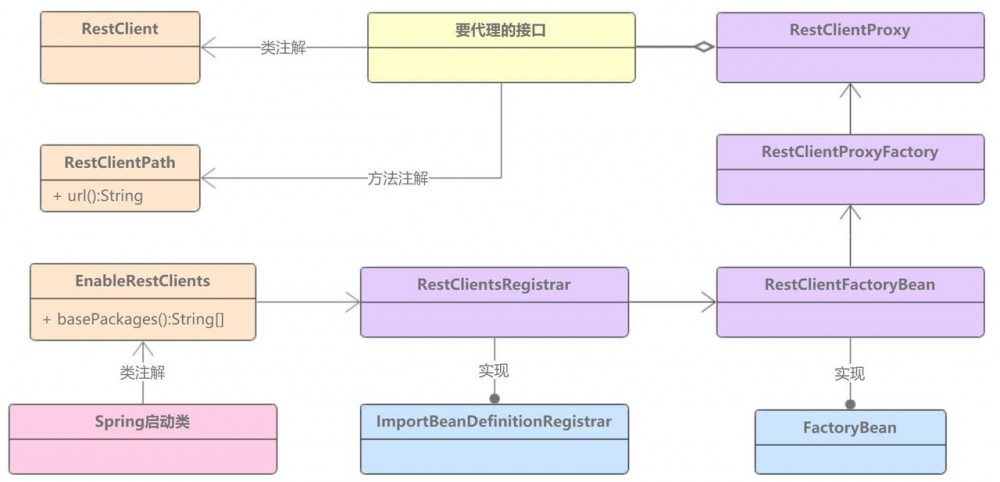重识Java动态代理(二)Spring中声明式编程实现
声明式编程的好处有:
- 代码简洁,不需要写很多相同的实现代码
- 对使用者屏蔽了实现细节,使用者只需要声明要做什么,而不关心怎么做。
二、适用场景
声明式编程适合封装公共的,不涉及业务逻辑的基础服务,例如远程调用,数据库访问。
三、Spring中声明式编程的实现
下面看一个在Spring中通过声明式编程实现远程访问的Demo,Demo类结构如下:

- EnableRestClients是一个Spring的启动类注解,用来声明是否要开启此功能,如果有此注解则开启,否则不开启。
- RestClient是要声明的远程接口的类注解,用来声明这些接口是否要实现远程调用。
- RestClientPath是要声明的远程接口的方法注解,用来声明该方法要调用的远程地址。
- RestClientsRegistrar是一个注册类,作用是动态注册远程接口的实现类。
- RestClientFactoryBean是一个工厂Bean,作用是将远程接口的实现作为一个Bean注册到Spring中。
- RestClientProxyFactory是一个代理工厂,用于生成远程接口的代理类。
- RestClientProxy是远程接口的代理类,调用远程接口方法时,实际调用的是代理类。
下面看下代码:
1.EnableRestClients.java
@Retention(RetentionPolicy.RUNTIME)
@Target(ElementType.TYPE)
@Documented
@Import(RestClientsRegistrar.class)
public @interface EnableRestClients {
/**
* 要扫描的接口类的包名
*
* @return
*/
String[] basePackages() default {};
}
复制代码
2.RestClient.java
@Target(ElementType.TYPE)
@Retention(RetentionPolicy.RUNTIME)
@Documented
public @interface RestClient {
}
复制代码
3.RestClientPath.java
@Retention(RetentionPolicy.RUNTIME)
@Target(ElementType.METHOD)
@Documented
public @interface RestClientPath {
/**
* 出于示例简单考虑,只有一个远程访问地址URL
*
* @return
*/
String url() default "";
}
复制代码
4.RestClientsRegistrar核心代码
public void registerFeignClients(AnnotationMetadata metadata, BeanDefinitionRegistry registry) {
ClassPathScanningCandidateComponentProvider scanner = getScanner();
scanner.setResourceLoader(this.resourceLoader);
System.out.println("this.resourceLoader: " + this.resourceLoader);
// 添加一个注解过滤器,有RestClient注解的类/接口才继续处理
AnnotationTypeFilter annotationTypeFilter = new AnnotationTypeFilter(RestClient.class);
scanner.addIncludeFilter(annotationTypeFilter);
// 这里的metadata是spring启动类上的注解元数据,下面这一步是获取EnableRestClients注解的属性
Map<String, Object> attributes = metadata.getAnnotationAttributes(EnableRestClients.class.getName());
// 得到EnableRestClients注解上的basePackages属性值,只扫描这些包下的class
Set<String> basePackages = new HashSet<>();
for (String pkg : (String[]) attributes.get("basePackages")) {
if (StringUtils.hasText(pkg)) {
basePackages.add(pkg);
}
}
for (String basePackage : basePackages) {
System.out.println("basePackage: " + basePackage);
Set<BeanDefinition> candidateComponents = scanner.findCandidateComponents(basePackage);
for (BeanDefinition candidateComponent : candidateComponents) {
if (candidateComponent instanceof AnnotatedBeanDefinition) {
AnnotatedBeanDefinition beanDefinition = (AnnotatedBeanDefinition) candidateComponent;
// 扫描到的接口/类的注解元数据
AnnotationMetadata annotationMetadata = beanDefinition.getMetadata();
// 得到RestClient注解的属性,这里不需要,因为在代理类中可以通过要代理的类的注解获得
// Map<String, Object> attributes = annotationMetadata
// .getAnnotationAttributes(RestClient.class.getCanonicalName());
registerRestClient(registry, annotationMetadata);
}
}
}
}
/**
*
* @Description: 注册Bean
* @param registry
* @param annotationMetadata
* @param attributes
*
* @Author 飞流
* @Date 2019年8月17日
*/
private void registerRestClient(BeanDefinitionRegistry registry, AnnotationMetadata annotationMetadata) {
// 这个类就是扫描到的要处理的类
String className = annotationMetadata.getClassName();
BeanDefinitionBuilder definition = BeanDefinitionBuilder.genericBeanDefinition(RestClientFactoryBean.class);
// 通过此方式给RestClientFactoryBean的成员赋值,将要实现的类传入
definition.addPropertyValue("type", className);
// 设置注入方式
definition.setAutowireMode(AbstractBeanDefinition.AUTOWIRE_BY_TYPE);
AbstractBeanDefinition beanDefinition = definition.getBeanDefinition();
// 通过RestClientFactoryBean生成指定类的实现,这个类就可以通过@Autowired注入了
BeanDefinitionHolder holder = new BeanDefinitionHolder(beanDefinition, className);
BeanDefinitionReaderUtils.registerBeanDefinition(holder, registry);
}
复制代码
- RestClientFactoryBean.java
class RestClientFactoryBean implements FactoryBean<Object>, InitializingBean, ApplicationContextAware {
private Class<?> type;
private ApplicationContext applicationContext;
@Override
public void afterPropertiesSet() throws Exception {
}
@Override
public Object getObject() throws Exception {
return RestClientProxyFactory.getProxy(type);
}
@Override
public Class<?> getObjectType() {
return this.type;
}
@Override
public boolean isSingleton() {
return true;
}
}
复制代码
- RestClientProxyFactory.java
public class RestClientProxyFactory {
public static Object getProxy(Class<?> clazz) {
RestClientProxy proxy = new RestClientProxy();
Object newInstanceObject = Proxy.newProxyInstance(clazz.getClassLoader(), new Class[] { clazz }, proxy);
return (Object) newInstanceObject;
}
}
复制代码
- RestClientProxy.java
public class RestClientProxy implements InvocationHandler {
@Override
public Object invoke(Object proxy, Method method, Object[] args) throws Throwable {
// 获取接口类方法上远程地址
RestClientPath path = method.getAnnotation(RestClientPath.class);
String url = path.url();
System.out.println("path.url(): " + url);
RestTemplate restTemplate = new RestTemplate();
// 这里arg[0]为方法参数
Object object = restTemplate.postForEntity(url, args[0], method.getReturnType()).getBody();
return object;
}
}
复制代码
- 接口类UserClient.java
@RestClient
public interface UserClient {
@RestClientPath(url = "http://localhost:7000/findUserByName")
ResponseResult<User> findUserByName(String userName) throws Exception;
@RestClientPath(url = "http://localhost:7000/createUser")
ResponseResult<Void> createUser(User user) throws Exception;
}
复制代码
可以看到这个接口类就是声明式的,通过注解来指定要调用的服务端地址,方法参数以及返回值和远程服务的参数和返回值对应,在实际调用时调用的是动态代理类实现的方法。
9. 接口类的使用
@RestController
public class CallUserController {
@Autowired
private UserClient client;
@PostMapping("/callFindUserByName")
public ResponseResult<User> callFindUserByName(@RequestBody String userName) throws Exception {
ResponseResult<User> response = client.findUserByName(userName);
return response;
}
@PostMapping("/callCreateUser")
public ResponseResult<Void> callCreateUser(@RequestBody User user) throws Exception {
return client.createUser(user);
}
}
复制代码
可以看到这里直接使用@Autowired注解来注入接口类,调用的也都是接口方法,而实际调用时会通过Java动态代理调用代理类的方法。
10. 模拟服务端
@RestController
public class UserController {
@PostMapping("/findUserByName")
public ResponseResult<User> findUserByName(@RequestBody String userName) throws Exception {
ResponseResult<User> response = new ResponseResult<User>();
User user = new User();
user.setUserName(userName);
user.setAge((int) (Math.random() * 50));
response.setResultObject(user);
return response;
}
@PostMapping("/createUser")
public ResponseResult<Void> createUser(@RequestBody User user) throws Exception {
ResponseResult<Void> response = new ResponseResult<Void>();
response.setResultMsg("Create user success.");
return response;
}
}
复制代码
可以看到服务端参数和返回值和客户端接口类保持一致。
至此就在Spring中实现了声明式编程,完整实例代码扫码加入微信公众号并回复:webfullstack,获取仓库地址。
end.
站点: javashizhan.com/
微信公众号:

正文到此结束
- 本文标签: find 数据库访问 CEO provider Property ip map HashSet DOM entity web id tar 代码 参数 BeanDefinition db cat Proxy Document src 远程访问 服务端 IDE 2019 REST 微信公众号 classpath 数据库 newProxyInstance App client java IO CDN 数据 rand value ACE ssl description Feign CTO build spring bean https UI tag 实例 http 站点
- 版权声明: 本文为互联网转载文章,出处已在文章中说明(部分除外)。如果侵权,请联系本站长删除,谢谢。
- 本文海报: 生成海报一 生成海报二
热门推荐
相关文章
Loading...











![[HBLOG]公众号](https://www.liuhaihua.cn/img/qrcode_gzh.jpg)

